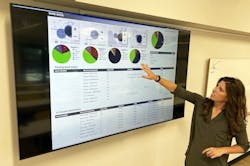West Side manages fleet’s PM across regions
West Side Tractor has built a machine data-driven maintenance-management system that allows it to centralize preventive maintenance for a customer’s far-flung fleet of more than 900 pieces of equipment.
As a John Deere dealer, West Side draws on the manufacturer’s deep support infrastructure behind the JDLink telematics and machine data systems. Lauren Coffaro, marketing and technology director for West Side, says the longtime, consultative relationship with the customer led to the development of the PM system. For reasons of confidentiality, West Side declined to identify the customer. The specialty contractor operates a limited range of machine types.
“It was a natural evolution,” Coffaro says. “They wanted to partner with us on a couple of key areas to help have more of a cohesive fleet-management experience.”
The contractor has a corporate equipment division, but PMs were being managed at the regional level, resulting in machines not being serviced on time. Kathrynn Wahl, fleet services manager, helped build and manages the program along with one assistant. The impetus for customer, she says, was the observation that downtime and repair costs were increasing.
“They knew preventative maintenance had something to do with it, but they didn’t have a consistent process in place to manage their preventative maintenance nationwide,” Wahl says.
Collaboratively, the customer and West Side implemented a system and structure based on John Deere service intervals with PM inspections and oil sampling during every service. In order to manage service on machines in regions outside of West Side’s, Wahl enlisted other John Deere dealers to perform the work. Those dealers perform the services, then submit their invoices, oil sample reports, and inspections to Wahl, who reviews for repair needs and processes for payment. She works with the regional supervisors and area dealers to coordinate any repairs identified during the services.
How does the dealer manage PMs?
Each week, Wahl identifies the machines due for PM, then she and her coordinator, Donna Brown, contact the site and determine who is responsible for each machine. She identifies the local John Deere dealer and contacts them to arrange service. She also compiles all data pertaining to machine that a dealer would need to do the work: upcoming PMs, service history, site contact and number, along with the necessary PM inspection document.
“All [the dealer] has to do is call the site contact, schedule it, bill me for it,” Wahl says.
“It’s a simple idea, but extremely effective,” she says. And, says Coffaro, it has created value for the customer.
VP Brian Benck explains the benefit to the other Deere dealerships:
“From the service side of it, we’re helping line up and bring business to local John Deere dealers wherever they [the customer] migrate to and work.”
As they say, success is in the numbers.
“When we started the project, we had 200 machines under our charge and 40 percent of the machines were overdue for service,” Wahl says. “Right now, we are standing on a little over 900 machines in our charge and current actionable is about 3 percent overdue for service.”
West Side also handles machine alerts for the fleet, regardless of machine location, contacting the same regional fleet people as Wahl out of its monitoring hub in Indianapolis.
“[The customer is] hearing from Kathyrnn and Donna on the PM/repair side and Cory on the alerts side,” Coffaro says. “Everyone at this customer knows Kathrynn, Donna, or Cory.”
Benck says West Side is also using this fleet’s machine data to expand how it services them. He says the data used to manage PMs is funneled up to product support manager Dave Wilson, who meets weekly with the customer’s corporate fleet manager to discuss the big issues that are going on with the fleet throughout the country, issues such as overall fleet health and downtime prevention.
On the sales side, West Side is using the data for asset management, including total cost of ownership. Planning, procurement, utilization, and disposal are ongoing discussions between the customer and West Side, Benck says.
“It goes beyond just getting PMs on time,” he says. “If we’re going to mix leasing into that and rental, what’s the mix we do there? What’s the best acquisition strategy?
“We’ve tried to create a churn chart [to help plan] for the next three to four years out,” he says. “What’s the age of the fleet, where do we start to see repairs on certain models creep up, that we feel like this is the ideal exit point for you to get the most money out of it. Then we have to have a whole remarketing approach on the backside that makes sure we help to dispose of those assets.”
About the Author
Rod Sutton
Sutton has served as the editorial lead of Construction Equipment magazine and ConstructionEquipment.com since 2001.
Our mission is to help managers of heavy equipment and trucks to improve their performance in acquiring and managing their fleets. One way we do that is with our Executive Institute, where experts share information and ideas that will enable equipment managers to accurately manage equipment costs so that they can deliver the optimum financial benefits to their organizations.
We also have a laser focus on product development, performance, and technology; as well as equipment acquisition, disposal, and maintenance. Our exclusive Field Tests take earthmoving equipment and truck into the field for professional evaluations.
Check out our free newsletters to see the latest content.
You can find Sutton on LinkedIn.

